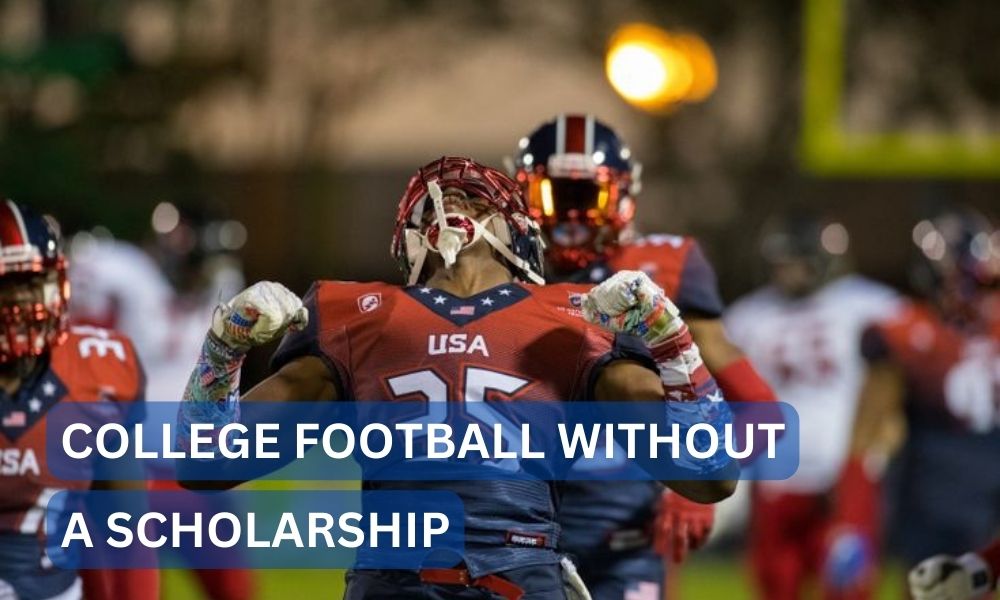College football is a dream for many aspiring athletes. The opportunity to compete at a high level, showcase their skills, and potentially earn a scholarship is a goal that drives countless young players. However, the reality is that not every player will receive a scholarship offer. So, can you still play college football without a scholarship? In this article, we will explore the options available for athletes who want to pursue their passion for football at the collegiate level, even without a scholarship.
The Importance of Scholarships in College Football
Before delving into the possibilities of playing college football without a scholarship, it is crucial to understand the significance of scholarships in the world of collegiate athletics. Scholarships are awarded to student-athletes based on their athletic abilities, academic achievements, and potential contributions to the team. These scholarships cover tuition fees, room and board, and sometimes even additional expenses.
For many athletes, receiving a scholarship is not only a validation of their skills but also a financial lifeline. It allows them to pursue their education while playing the sport they love, without the burden of hefty student loans. Scholarships also provide athletes with access to top-notch coaching, training facilities, and exposure to scouts and recruiters, increasing their chances of playing at the professional level.
Read:Can you get a scholarship for paintball?Playing College Football as a Walk-On
While scholarships are highly sought after, they are not the only pathway to playing college football. Many athletes choose to walk-on to a team, meaning they join the team without a scholarship. Walk-ons are players who try out for the team during open tryouts or are invited to join the team by the coaching staff.
Walking on to a college football team requires dedication, perseverance, and a strong work ethic. It is a highly competitive process, as coaches have limited spots available for walk-ons. However, with the right skills, attitude, and determination, it is possible to earn a spot on the team and compete at the collegiate level.
One notable example of a successful walk-on is Rudy Ruettiger, whose story was immortalized in the movie “Rudy.” Despite facing numerous obstacles, including his small stature and lack of natural talent, Ruettiger’s unwavering determination and relentless work ethic earned him a spot on the Notre Dame football team. His story serves as an inspiration to aspiring walk-ons, showcasing that anything is possible with the right mindset.
The Benefits and Challenges of Being a Walk-On
Playing college football as a walk-on comes with its own set of benefits and challenges. Let’s explore some of the advantages and drawbacks of this path:
Read:Can you get a full scholarship to ucla?Benefits:
- Opportunity to prove oneself: Walking on to a team allows athletes to showcase their skills and prove their worth to the coaching staff. It provides a chance to compete against scholarship players and demonstrate their abilities.
- Access to resources: While walk-ons may not receive the same financial benefits as scholarship players, they still have access to top-notch coaching, training facilities, and equipment. This can significantly enhance their development as athletes.
- Potential for scholarships: Although initially joining the team as a walk-on, there is always the possibility of earning a scholarship in the future. Coaches often reward hard work, dedication, and exceptional performance with scholarships.
Challenges:
- Financial burden: Without a scholarship, walk-ons are responsible for covering their tuition fees, room and board, and other expenses. This can be a significant financial burden, especially for athletes from low-income backgrounds.
- Less playing time: Scholarship players often receive priority when it comes to playing time, as coaches have invested in their development. Walk-ons may have to work harder to earn playing time and prove themselves on the field.
- Limited support: Walk-ons may not receive the same level of support and resources as scholarship players. They may have to navigate the college experience, including academic and personal challenges, with fewer resources and guidance.
Alternative Pathways to College Football
While walking on to a college football team is a viable option for many athletes, it is not the only pathway to playing the sport at the collegiate level. There are alternative routes that athletes can explore to continue their football journey:
Read:Does juco offer athletic scholarships?Junior College Football:
Junior colleges, also known as community colleges, offer football programs that provide opportunities for athletes to develop their skills and gain exposure. Junior college football serves as a stepping stone for players who may not have received scholarship offers out of high school or need additional time to mature physically and academically.
Junior college football allows athletes to compete at a high level while improving their skills and academic standing. It provides a platform for players to catch the attention of four-year college coaches and potentially earn a scholarship offer after completing their junior college eligibility.
Division III Football:
Division III colleges and universities do not offer athletic scholarships. However, they provide opportunities for athletes to continue playing football while focusing on their academics. Division III football programs prioritize the student-athlete experience, emphasizing the balance between academics and athletics.
While Division III football may not offer the same level of competition as Division I or II, it still provides a platform for athletes to compete, develop their skills, and enjoy the camaraderie of being part of a team. Division III athletes often have the flexibility to pursue other interests and activities alongside their football commitments.
Preferred Walk-On:
Some athletes receive preferred walk-on offers from college football programs. A preferred walk-on is a non-scholarship player who is guaranteed a spot on the team roster. While they do not receive a scholarship initially, they may have the opportunity to earn one in the future based on their performance and contributions to the team.
Preferred walk-ons are often recruited by college coaches and may receive certain benefits, such as early access to training facilities, academic support, and the opportunity to compete for playing time. This pathway provides a middle ground between being a walk-on and a scholarship player, offering a higher level of support and recognition.
Conclusion
While scholarships are highly coveted in college football, they are not the only pathway to playing the sport at the collegiate level. Walk-ons, junior college football, Division III football, and preferred walk-on offers all provide opportunities for athletes to pursue their passion for football and compete at a high level.
Playing college football without a scholarship requires dedication, perseverance, and a strong work ethic. It may come with financial challenges and limited support, but for those who are truly passionate about the sport, the opportunity to compete and prove oneself can outweigh the drawbacks.
Ultimately, the journey of playing college football without a scholarship is a testament to an athlete’s love for the game and their determination to succeed. Whether it is through walking on, attending a junior college, or joining a Division III program, athletes can find their own path to the gridiron and continue their football journey at the collegiate level.









